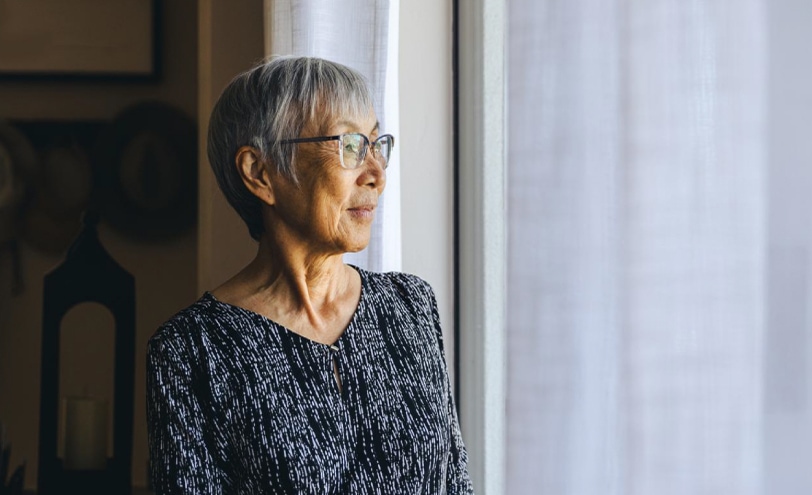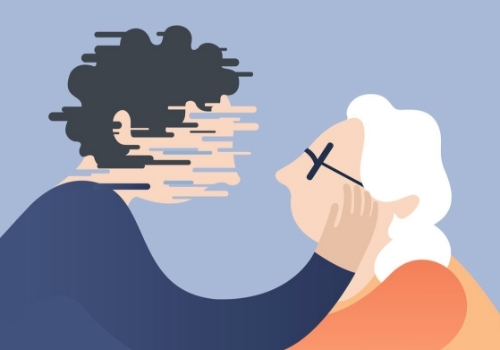Every three seconds, someone around the world develops Alzheimer’s Disease or a Related Dementia (ADRD)1
The number of Alzheimer’s patients is on the rise in Asia Pacific. In the absence of a cure, new innovations and research is changing the way we tackle the looming crisis.
The greatest pleasures in life are often the simplest – memories of our childhood, singing the lyrics to a favourite song or recounting fond adventures with an old friend many years later. But these cherished moments are also the very things that Alzheimer’s disease erases, forever.
Slowly affecting memory and thinking skills, Alzheimer’s disease is the most common form of dementia.1 Symptoms eventually grow severe enough to interfere with the ability to carry out the simplest tasks. Like no other illness, it’s an attack on a person’s identity, profoundly changing who they are, or once were. It fades away their past and future, stealing memories and turning loved ones into strangers.

Worldwide, more than 55 million people are living with some form of dementia.1 In Asia Pacific, the increasing prevalence of Alzheimer’s disease presents an enormous challenge for health systems, now and in the future. According to Alzheimer’s Disease International (ADI), a global federation of Alzheimer’s associations around the world, 60% of dementia patients live in Low – and Middle-Income Countries (LMICs).2 Because of a lack of awareness and misconceptions, a majority of dementia cases continue to remain undiagnosed, placing immense burden – directly and indirectly – on individuals, their families and society at large.3

The burden of love
Watching a once mentally sharp loved one decline before our very eyes is heartbreaking. Alzheimer’s disease is not only life-changing for the person diagnosed, but also for those around them. Caring for someone with Alzheimer’s disease involves physical, mental, emotional, and financial commitment. With high levels of dependency as well as morbidity in its later stages, dementia requires a range of care services from both within and outside the health sector.
In Asia Pacific, dementia care cost is estimated at US$ 180 billion, burdening the health systems of emerging economies with large populations.4 Additionally, 65% of the costs in LMICs are attributable to informal care, which is primarily provided by family members, making caregiver burnout a pressing public health issue.5 On average, caregivers spend five hours a day providing support for daily living; 70% of that care is provided by women. Given the financial, social, and psychological stress faced by carers, access to information, training and services, as well as social and financial support is particularly important.
While diagnosis is the first step to accessing any dementia care and support, limited access to diagnostic services along with other barriers impede care progress. The World Health Organization’s (WHO) report on the ‘Public health response to dementia’ calls for strengthening care and support, not only for people with dementia but also for those providing care, in both formal and informal settings. Dr Tedros Adhanom Ghebreyesus, Director-General of the World Health Organization says, “Building the services and systems to prevent, delay, and mitigate the effects of dementia and providing quality care for people with dementia and their families is essential now, and for the future in our ageing world.”
A national priority
Rising to the challenge, some countries in Asia Pacific have already developed national dementia strategies.6 High-income nations like Australia have allocated $229 million to expand and strengthen its dementia support program as part of its annual 2021-2022 budget.7 Similarly, South Korea is making dementia a public health priority by setting up a dedicated task force and creating policies and legislation for dementia.8 With a burgeoning elderly population, Japan too is at the forefront of driving change to tackle the dementia crisis.9,10 Towns and cities across the country are attempting to move away from a medicine-based, institutional approach towards care that involves the entire community. The government’s ‘Orange Plan’ is a comprehensive package of measures to tackle dementia and ranges from more specialised medical staff to regular home visits and support for family caregivers.11
Following their footsteps, emerging economies have also begun to take positive steps towards tackling the war against dementia. As part of a two-year project funded by WHO’s Kobe Centre for Health Development (WKC), Laos, the youngest of the 10-member ASEAN bloc with a median age of 22.7 years, launched its first national survey to assess adults over 60 with low cognitive function.12,13 This initiative will not only help the country gather evidence-based data but will also provide authentic information to revise outdated policies for the elderly.
Improving care through early detection
If breakthroughs in Alzheimer’s disease research and clinical trials are not discovered, the numbers worldwide could exceed 152 million by 2050.14,15 Nevertheless, as the search for a cure continues, the rising burden of Alzheimer’s disease has led to a growing demand for technological advancements in the treatment and early intervention of dementia. Timely diagnosis using biomarkers can detect physiological changes years before symptoms appear.
Research to date has shown scientists that, for any potential treatment to be successful, the disease needs to be detected and diagnosed as early as possible. The earlier treatment starts, the more impact it will have on how the disease progresses.
Watch this video as Jeff Borghoff shares his story of finally receiving a diagnosis after being misdiagnosed with several neurological diseases. He and his wife Kim had pursued an answer for 18 months, and then there it was: Alzheimer’s. Learn more about Jeff’s story here.
Two of the earliest signs of Alzheimer’s disease are the ‘plaques’ and ‘tangles’ that develop in the brain, caused by the build-up of certain proteins. By accurately measuring these proteins, we can gain a better understanding of how the disease unfolds and extend the quality of life.16 This gives caregivers and patients more time to prepare for what is to come, and creates support for them within their communities and the health system.
While biomarkers increase the certainty of an Alzheimer’s diagnosis, there remains a pressing need to look to the future and continue investing in research and innovations that can tackle this growing public health issue.17 Data has revealed that people are more scared of dementia than of other top causes of death, like heart disease.18 Concerns over the impact on their daily lives – particularly their jobs, social engagement, and ability to drive – stop them from seeking an early diagnosis. However, the benefits of an early diagnosis far outweigh such fears.
The WHO states that “increasing public awareness, acceptance, understanding of dementia, and making the society environment friendly will enable people with dementia to participate in the community and maximise their autonomy through improved social participation”.19 Moreover, being diagnosed with Alzheimer’s Disease does not mean they’re dying tomorrow. The focus needs to be on the caregivers and models for person-centered care as it can be an effective way forward to prevent and manage behavioural and psychological symptoms that are an integral part of Alzheimer’s Disease.20 Dementia is so often viewed as an inevitable symptom of ageing, but with foresight and preparation, it can be steered towards a gentler course.
References:
- World Health Organization (2020). Dementia. Retrieved from: https://www.who.int/news-room/fact-sheets/detail/dementia
- Alzheimer’s Disease International. Retrieved from: https://www.alzint.org/about/dementia-facts-figures/dementia-statistics/
- Linda Lang et al., 2017. “Prevalence and determinants of undetected dementia in the community: a systematic literature review and a meta-analysis” https://www.ncbi.nlm.nih.gov/pmc/articles/PMC5293981/
- Alzheimer’s Disease International. “Dementia in the Asia Pacific Region” Retrieved from: https://www.alzint.org/u/Dementia-Asia-Pacific-2014.pdf
- Global status report on the public health response to dementia. Retrieved from https://apps.who.int/iris/bitstream/handle/10665/344701/9789240033245-eng.pdf
- Fei Sun et al., 2020. “National policy actions on dementia in the Americas and Asia-Pacific: Consensus and challenges”. https://iris.paho.org/bitstream/handle/10665.2/51808/v44e22020.pdf?sequence=5&isAllowed=y
- Alzheimer’s Disease International. “Australia’s $229m commitment to dementia” https://www.alzint.org/news-events/news/australias-229m-commitment-to-dementia/
- Alzheimer’s Disease International. Technology & National Dementia Plans: Lessons from the Korean experience” https://www.alzint.org/news-events/events/technology-national-dementia-plans-lessons-from-the-south-korean-experience/
- The World Bank. Retrieved from https://data.worldbank.org/indicator/SP.POP.65UP.TO.ZS?locations=JP
- Soeren Mattke et al.,2019. “Assessing the Preparedness of the Japanese Health Care System Infrastructure for an Alzheimer’s Treatment” https://cesr.usc.edu/sites/default/files/Japan_Infrastructure_Report_Update_f2%5B1%5D.pdf
- Japan Health Policy Now. Retrieved from https://japanhpn.org/en/1-2/
- WHO Retrieved from https://extranet.who.int/kobe_centre/en/news/Lao_Dementia_UHC
- Research Project on Care for older Persons in ASEAN +3 https://extranet.who.int/kobe_centre/en/news/Lao_Dementia_UHC
- Jennifer L. Watson et al.,2015. Obstacles And Opportunities In Alzheimer’s Clinical Trial Recruitment. https://www.ncbi.nlm.nih.gov/pmc/articles/PMC4167360/
- Estimation of the global prevalence of dementia in 2019 and forecasted prevalence in 2050: an analysis for the Global Burden of Disease Study 2019 The Lancet https://www.thelancet.com/journals/lanpub/article/PIIS2468-2667(21)00249-8/fulltext
- 16. Clifford R Jack Jr et al,.2010. Hypothetical model of dynamic biomarkers of the Alzheimer’s pathological cascade. Lancet Neurol 2010; 9:119-28. https://www.thelancet.com/journals/laneur/article/PIIS1474-4422(09)70299-6/fulltext
- Biomarkers: Changing the way Alzheimer’s Disease is diagnosed Retrieved from https://www.roche.com/stories/biomarkers-in-alzheimers
- Dementia Attitudes Monitor. Retrieved from https://www.dementiastatistics.org/wp-content/uploads/2021/09/ALZ_DAM_short-Report_21_LR-WEB_FINAL2.pdf#zoom=80
- The World Health Organization. Retrieved from https://apps.who.int/iris/bitstream/handle/10665/259615/9789241513487-eng.pdf?sequence=1
- Alzheimer’s Society. https://www.alzheimers.org.uk/about-dementia/treatments/person-centred-care














